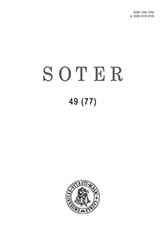Kauno bažnyčių lietuvėjimas XX a. 3-iajame dešimtmetyje
The lithuanization of churches in Kaunas in 1930s
Author(s): Mindaugas BalkusSubject(s): Christian Theology and Religion
Published by: Vytauto Didžiojo Universitetas
Keywords: Katalikai; Bažnyčios; Lietuvėjimas; Pridėtinės pamaldos; Lietuviai; Lenkai; Konfliktai; Catholics; Churches; Lithuanization; Additional services; Lithuanians; Poles; Conflicts
Summary/Abstract: Straipsnyje nagrinėjamas procesas, lėmęs tai, kad Kauno bažnyčiose XX a. 3-iajame dešimtmetyje lietuvių kalba tapo pagrindine pridėtinėse pamaldose vartojama kalba (skaitant Evangeliją, sakant pamokslus, giedant giesmes ir kt.). Apžvelgiami Šv. Kryžiaus (karmelitų), Švč. Trejybės ir Švč. Jėzaus Širdies (Šančių) bažnyčiose tarp lietuviakalbių ir lenkakalbių tikinčiųjų 1923–1924 m. kilę konfliktai dėl vyravimo pridėtinėse pamaldose (kalbos atžvilgiu The object of the research is the process by which Lithuanian language gradually gained a dominant position in additional services (in the part of Church’s ritual, which was not held in Latin, but in lingua vernacula, i.e., Gospel readings, preaching, singing hymns, etc.). The study is based on the material from archival funds (Kaunas Archdiocese Archives and Lithuanian State Historical Archives) and periodical press. At the beginning of the 20th century the majority of additional services in Kaunas Cathedral Basilica (including the noon mass) were held in Polish (the part of Church’s ritual, which was held in lingua vernacula). This situation did not satisfy the interests of the majority of Kaunas Lithuanian Catholics. Lithuanian public’s permanent appeals to Samogitian Bishop and dissatisfaction expressed in the press determined that in December of 1923 Chapter of Samogitian Diocese decided that all additional services of Holidays at Kaunas Cathedral Basilica must be held only in Lithuanian language. At the beginning 1930s most additional services in Kaunas churches were held in Polish (the part of Church’s ritual, which was held in lingua vernacula). This situation did not satisfy the national composition of Kaunas population which had changed. According to the data of 1923 General census of the Lithuanian population, about 60.83 percent of Kaunas residents were Lithuanians and about 4.37 percent were Poles. The situation presupposed the need of the lithuanization of churches in Kaunas. In the end of 1923 and in the beginning of 1924 the strife became apparent between Lithuanian-speaking and Polish-speaking believers in the St. Cross (Carmelite), St. Trinity and Blessed Sacred Heart of Jesus (Šančiai) churches. The strife was caused by disagreements on the language of additional services. In 1924 Samogitian Bishop changed the order (from the linguistic point of view) of additional services in these churches and national friction was normalized. The incident of the 26th of September 1926 in the St. Trinity Church during Polish commemorative procession was encouraged by the negative reaction of part of Lithuanian society to left-wing government’s greater degree of freedom granted to the minorities in state’s public life. Part of Lithuanian society considered Polish Jubilee procession as demonstrative Lithuanian Poles parade in the main city of the state, which symbolized for Lithuanians their dominant position in the state.
Journal: SOTER: religijos mokslo žurnalas
- Issue Year: 77/2014
- Issue No: 49
- Page Range: 23-35
- Page Count: 13
- Language: Lithuanian

